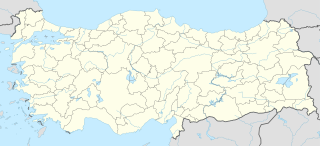Holy Apostles Monastery
| Arakelots Monastery | |
|---|---|

The monastery in the early 20th century. Photo by Vartan A. Hampikian, published in New York in 1923
|
|
| Basic information | |
| Location | Arak (Kepenek) Köyü,Muş Province, Turkey |
| Geographic coordinates | 38°41′45″N 41°31′10″E / 38.695786°N 41.519517°ECoordinates: 38°41′45″N 41°31′10″E / 38.695786°N 41.519517°E |
| Affiliation | Armenian Apostolic Church |
| Country | Turkey |
| Status | Destroyed |
| Architectural description | |
| Architectural type | Monastery |
| Architectural style | Armenian |
| Founder | Gregory the Illuminator |
| Groundbreaking | early 4th century (traditional date) 11th century (earliest verifiable date) |
| Completed | 11th–12th centuries |
Arakelots Monastery (Armenian: Մշո Սուրբ Առաքելոց վանք, Mšo Surb Arakelots vank' , "Holy Apostles Monastery of Mush") was an Armenian monastery in the historic province of Taron, 11 km south-east of Mush (Muş), in present-day eastern Turkey. According to tradition, Gregory the Illuminator founded the monastery to house relics of several apostles. The monastery was, however, most likely built in the 11th century. During the 12th-13th centuries it was a major center of learning. In the following centuries it was expanded, destroyed and renovated. It remained one of the prominent monasteries of Turkish (Western) Armenia until the Armenian Genocide of 1915, when it was attacked and subsequently abandoned. It remained standing until the 1960s when it was reportedly blown up. Today, ruins of the monastery are still visible.
The monastery was most commonly known as Arakelots, however, it was also referred to as Ghazaru vank (Ղազարու վանք; "Monastery of Lazarus"), after its first abbot Yeghiazar (Eleazar). It was also sometimes known as Gladzori vank (Գլաձորի վանք), originating from the nearby gorge called Gayli dzor (Գայլի ձոր, "Wolf's gorge").
Official Turkish sources refer to it as Arak Manastırı, a Turkified version of its Armenian name. Turkish sources and travel guides generally omit the fact that it was an Armenian monastery.
According to "a late medieval tradition", the monastery was founded in the early 4th century (in 312 AD according to one author) by Gregory the Illuminator to house various relics of apostless he transferred from Rome. "Those relics (which included the left arms of Saint Peter and Saint Paul and right arm of the apostle Andrew) account for the monastery's name." According to Christina Maranci, evidence shows that the monastery was constructed in the latter half of the 11th century during the rule of the Tornikians—a branch of Mamikonians—who ruled Taron between 1054 and 1207. She writes that it is this era "which most scholars date the earliest portion of the structure." According to an inscription on a khachkar, it was renovated in 1125. In the east side of the monastery there were nine 11th century khachkars with inscriptions.
...
Wikipedia

